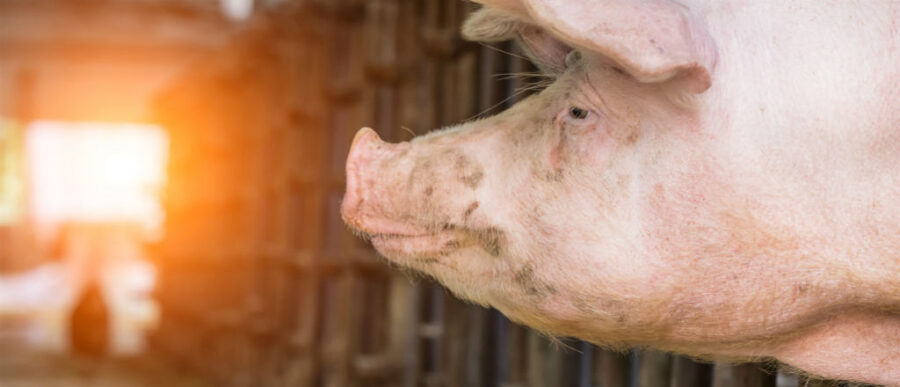China is the largest world’s pork producer, accounting for more than half the total production of a little over 113 million tons, according to the latest data; it is the largest consumer of pork as well. However, China’s swine farms are relatively small, compared to U.S. farms, and can suffer from food safety and quality issues. Amid forecasts of animal protein shortages in the future, observers say Chinese swine farmers would benefit from exposure to more efficient farming practices as well as business leadership skills to prepare for the future.
Recognizing that imperative, the Penn Wharton China Center in Beijing and the Penn School of Veterinary Medicine have been working with a group of pork producers in China over the past couple of years. The educational program they created aims to help improve productivity, introduce sustainable swine farming practices, including animal welfare, and inculcate business and leadership skills. The program has funding support from the Penn China Research and Engagement Fund and has a partner in Parsippany, N.J.-based Zoetis, a leading producer of medicines and vaccines for pets and livestock.
According to Thomas Parsons, professor of swine production medicine at the Penn School of Veterinary Medicine, the need for upgrading China’s pork industry is more important than ever before. He noted that over the past 40 years, the country’s per capita consumption of pork has increased 15 times. “With that rapid and almost exponential growth in the business, it is clear that they would also benefit from some extended business training,” he added.
The program covers 30 of the top pork producers in China, who account for a quarter of the country’s pork production. “There has been a lot of interest in terms of training people at the barn level,” said Parsons, who brings the “content expertise” to the program.
Many of China’s top pork producers are “family businesses … that are looking to professionalize,” said Anne Greenhalgh, deputy director of the Wharton Leadership Program and an adjunct professor of management at the school. She is helping develop the business skills, including soft skills in leadership, for the program’s participants. Among the various components of the program was a session she arranged for participants to listen to Wharton management professors Michael Useem and Harbir Singh share insights from their book “Fortune Makers: The Leaders Creating China’s Great Global Companies.” They also delivered a tutorial on strategic leadership for the participants.
Parsons and Greenhalgh shared their insights on the challenges and opportunities for China’s swine farmers on the Knowledge at Wharton show on SiriusXM channel 111. (Listen to the full podcast using the player at the top of this page.)
“If half the pigs in the world aren’t aligned with [best practices in swine farming], we’re not going to see global sustainability.”–Thomas Parsons
Building a Sustainable Model
China could learn sustainable swine farming practices from the evolution of the U.S. pork industry over the past three decades, said Parsons. Currently, less than 10% of U.S. swine farms produce 95% of all the pork in the country, he added.
Land ownership patterns present the biggest challenge in bringing best practices to agriculture in China, said Parsons. In the absence of private land ownership, the business models in Chinese agriculture are significantly different from those in the U.S., he said. “To undergo rapid growth, they have to have access to both land and resources [such as] capital financing,” he added.
Since the business models for swine farming in China and in the U.S. are vastly different, it is important to consider which aspects of the U.S. model are replicable and which are not, said Parsons. For example, preparing Chinese swine farmers for more favorable land ownership structures will be useful. “The overarching academic goal here is to see if we can identify knowledge gaps, and do collaborative research to help fill in the information they might need to negotiate their path forward,” he said. “Are they going to get to chance not to make some of the mistakes that we made?”
A shift towards intensive swine farming is one of the most important needs the program addresses, said Parsons. He noted that 98% of the farms in China have fewer than 50 animals each, and they account for about a third of the production in the country. The Chinese government has shown some interest to shift away from that “extensive format” to a more “intensive, structured and industrialized model,” chiefly because it will be easier to monitor and regulate the industry, he added. Food quality and safety are other issues the program addresses. “If half the pigs in the world aren’t aligned with [best practices in swine farming], we’re not going to see global sustainability.”
Global Ripple Effects
Bringing increased efficiencies to swine farming is important also because the demand for animal protein is increasing with global population growth. The U.N. Food and Agriculture Organization has projected that by 2050, the demand for animal protein will probably outstrip the planet’s ability to produce it, he noted. “So we’re trying to understand how we can be more efficient in [swine farming] processes.”
It is important to bring those efficiencies also because of China’s pork imports. China’s pork consumption as of April 2018 was nearly 56 million tons. Whenever demand exceeds domestic production, China’s government relies on imports to subsidize local prices.
Two years ago, China had to import pork because a severe disease outbreak reduced supply, Parsons said. China has also been trying to determine the right herd size, in part driven by environmental concerns, he noted. Two years ago, “it reduced its herd size by the total number of pigs we have in [the U.S.],” he recalled. “That might have been a bit of an over-correction because they ended up with shortages and so they were back in the market because [domestic] pork prices went way up.” All those moves have “huge ripple effects in Europe and across the world’s pork economies,” he pointed out.
Ethical Concerns
According to Parsons, over the last 40 years, the top challenge in swine farming was to make it scalable, and the next was ensuring quality. “Now, it has to become socially acceptable,” he said.
Swine farming has always been “a volatile and risky industry” because of biological variations in the animals, but recent years have seen increasing concerns over animal welfare as well. “That’s what we see as you get a burgeoning middle class that has enough disposable income to be able to care about where their food comes from,” Parsons said. “They’re starting to ask ethical questions.”
“It is about recognizing the path of the industry here [in the U.S.], what mistakes have we made, what have we learned, and how might we share [those insights] with the Chinese.”–Anne Greenhalgh
According to Parsons, the major concerns relating to swine farming in China are the environmental impact, followed by public health as that relates to food safety and the resistance of pigs to antibiotics. Animal welfare is lowest among the priorities, he said. However, he wants to acquaint the thought leaders among the program’s participants to those issues “so that they’re ready” when they become important in China as well.
Greenhalgh said that she and Parsons are also conscious of their program’s policy backdrop — the changing trade relationship between the U.S. and China. “What happens to soybeans affects pork, and affects prices, so we’re very thoughtful about walking into that situation,” she added.
Lessons from China for the U.S.
One area where China could provide a learning opportunity for the U.S. is in the interest its technology leaders have shown in the pork industry, Parsons said. “Given the importance of pork as a cultural entity, many of their Jeff Bezos types who’ve been successful in the tech realm are investing in the pork industry and seeing how they can apply their technology” to the industry, he said. They are looking at also using artificial intelligence to help manage swine farming, he added.
As the program continues, Greenhalgh and Parsons have been periodically visiting Chinese swine farms and working with the producers there to help improve efficiencies, and explore how advanced technology could help. Greenhalgh said she plans to use material put together by Useem and Singh for case discussions in the program. The program’s participative format for leadership training has resonated well with the participants, even as they may have been used to a top-down educational format, she added.
Greenhalgh said she and Parsons approach the program “not necessarily as the people with the right answer or the best answer,” but aim “to have a conversation and a dialogue” with the participants. “It is about recognizing the path of the industry here [in the U.S.], what mistakes we have made, what have we learned, and how might we share [those insights] with the Chinese.”



